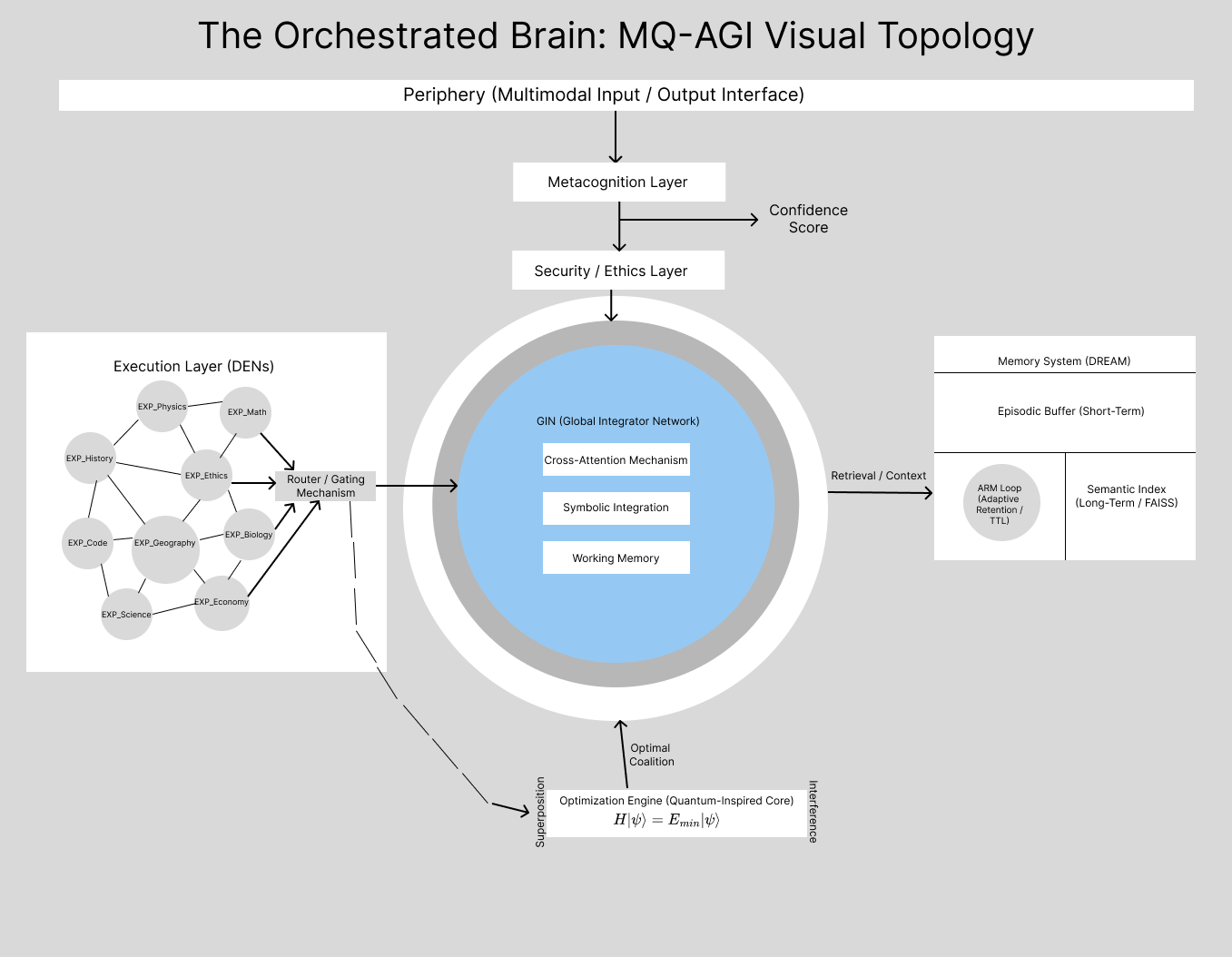We are living in the golden age of Large Language Models (LLMs). Models like GPT-5 and Claude 3 have shown us glimpses of reasoning that feel almost human. But if you look closely, you’ll see the cracks in the foundation.
Despite their size, these models are essentially "dense monoliths." They suffer from catastrophic forgetting (learning new things overwrites old ones), lack deep "System 2" reasoning (they predict the next token rather than planning), and operate as black boxes where safety is a patched-on filter, not a core constraint.
The industry's current answer is "Scale is All You Need" just add more data and compute. But evidence suggests we are hitting diminishing returns. To reach true Artificial General Intelligence (AGI), we don't just need a bigger brain; we need a better organized one.
That is why I am publishing MQ-AGI (Modular Quantum-Orchestrated Artificial General Intelligence), a new architectural blueprint designed to break the monolith and solve the structural bottlenecks of modern AI.
What is MQ-AGI?
MQ-AGI is a neuro-symbolic framework that moves away from the single giant neural network. Instead, it proposes an "Orchestrated Brain" topology inspired by the Global Workspace Theory of cognitive science.
It decomposes intelligence into specialized components that are coordinated by a central core, much like the human brain uses different regions for vision, language, and planning, unified by consciousness.
Here are the four pillars that define MQ-AGI:
1. The Orchestrated Brain (GIN & Experts)
Instead of one model that tries to know everything (and often gets confused), MQ-AGI uses Domain Expert Networks (DENs).
- We have a distinct expert for Physics, another for Law, another for Ethics. They are the "System 1"—fast and intuitive.
- Coordinating them is the Global Integrator Network (GIN). This is the system's "Prefrontal Cortex" ("System 2"). It receives inputs from experts, thinks, resolves conflicts, and maintains the train of thought.
2. Quantum-Inspired Optimization
This is the critical innovation. How do you choose the perfect combination of 5 experts out of 1,000 to solve a complex problem? MQ-AGI treats this not as a statistical guessing game, but as a Combinatorial Optimization Problem.
- The architecture models decision-making using a Hamiltonian Energy function.
- It seeks the "Ground State" (lowest energy) which represents the optimal coalition of experts that minimizes logical conflict and maximizes relevance.
- Note: This doesn't require a quantum computer today. The paper details how to run this via Tensor Networks on GPUs, while being ready for future quantum hardware.
3. Infinite Memory (The DREAM Protocol)
An AGI cannot have amnesia. MQ-AGI integrates the DREAM protocol (my previous work on episodic memory).
- It replaces the limited "context window" with a self-managing episodic memory.
- It uses Adaptive Retention (TTL): memories that are useful get stronger and live longer; useless noise is forgotten. This allows the system to "grow up" with the user over years, not just minutes.
4. Constitutional Safety (Ethics as Physics)
In current LLMs, you can "jailbreak" safety filters because they are just text instructions. In MQ-AGI, ethical constraints are encoded as energy costs in the decision core. An unethical action has such a "high energy cost" that the system is physically incapable of collapsing into that decision state. Safety becomes a law of physics within the model, not just a suggestion.
Why This Matters
We are reaching the limits of what "brute force" scaling can do. The next leap in AI will come from architecture systems that are modular, inspectable, and efficient.
MQ-AGI offers a concrete roadmap to build systems that are not just smarter, but more coherent, personalized, and safe by design.
Read the Full Paper
I have released the complete technical paper, including the mathematical formalization (Hamiltonians, Free Energy Principle), critical feasibility analysis, and implementation roadmap as an open-access preprint.
Whether you are a deep learning researcher or a systems architect, I invite you to review the blueprint and join the discussion on the future of modular AI.
📄 Access the MQ-AGI Paper on Zenodo: https://zenodo.org/records/17654543
